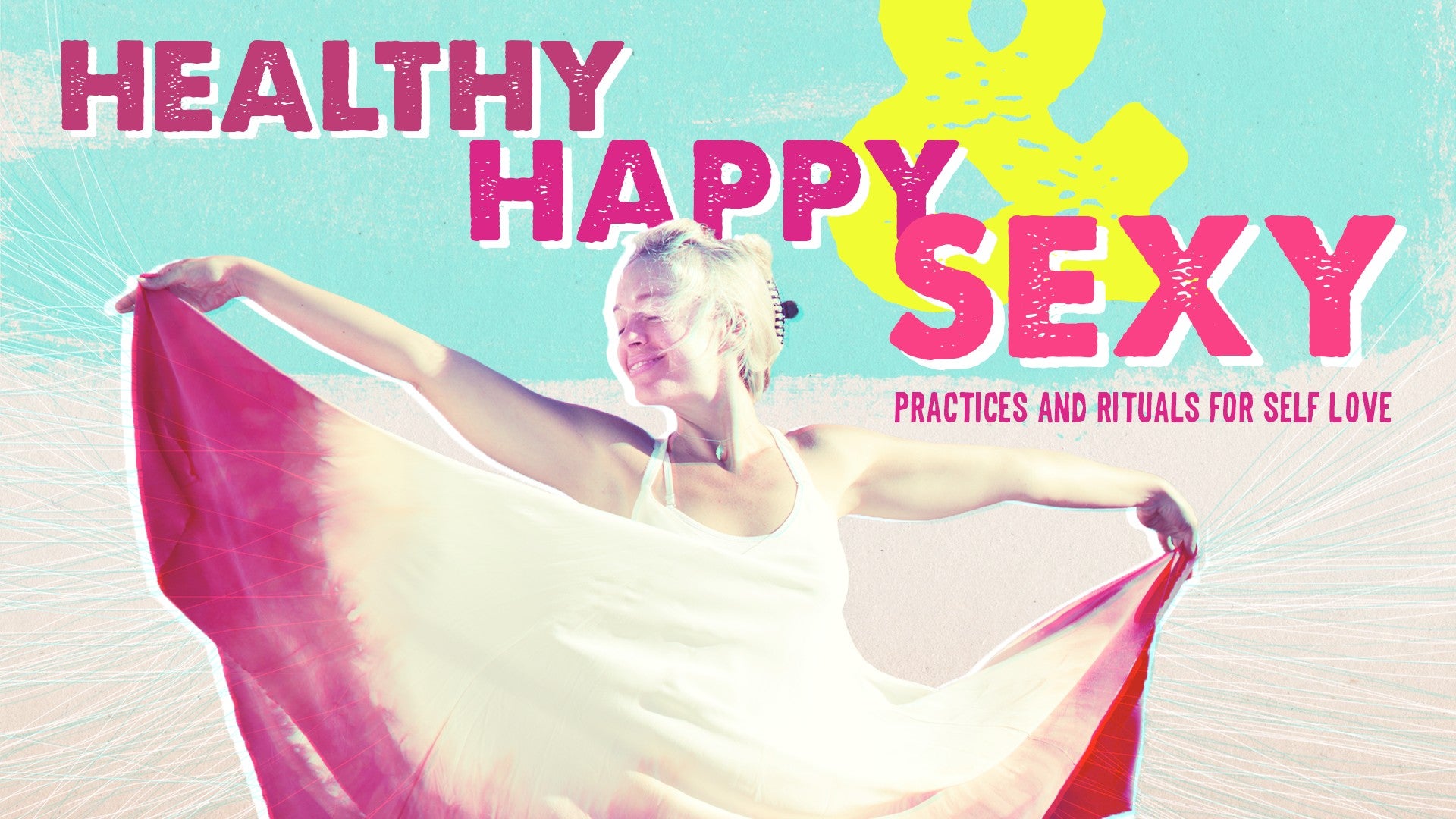Description
About This Video
Transcript
Read Full Transcript
(water flowing) Let's do a practice that we all need. A practice for restoring and renewing and reviving. You can get maximum benefit from this practice by engaging your mind deep down into the belly and particularly the back body right around where your kidneys and adrenal glands are. So right now what I'd like for you to do is bring your hands back behind you and just place your hands on your lower back and take a few deep inhales into the palms. This is breathing into the back body.
Many of these poses will engage us with the back body in such a way that's almost kind of forced into our realm of awareness. When you watch a cat or a dog sleeping, you'll see that they have a massive breath in their back body and it's just really the most healing and nurturing breath, and it activates the parasympathetic nervous system, which is the part of our nervous system that makes us feel calm. So I'll continually be inviting you to come back into breathing in that part of your body. Remember this practice is much more about not doing than doing, okay. So to begin, I'd like for you to have something like this bolster.
Another thing we can work is a couple of blankets stacked up one on top of the other. Just really something stable to give you height. If you don't have a bolster, that's fine. You can still do this practice, okay. So I'm gonna come onto all fours, and I'm gonna bring my bolster with me.
We're gonna go into child's pose, which you may be very familiar with, but what I'd like for you to do is bring the knees wide as much as you can big toes touch more or less there. And then I'm gonna slide the bolster in between the groins, and then we're gonna slowly start to come forward, okay. And just like we did in the water practice with me, I want you to let yourself really just sort of undulate forward into the pose. Take a moment, breathe into the back body. And then you're gonna feel where does it feel right for me to place this bolster, right.
You'll just feel this kind of ah sensation. And then turn the head to one side. You can keep the arms extended out in front of you. You can bring them back behind you. Good, and now what you're noticing perhaps is because of the position of the bolster, it's actually forcing my belly upward and bringing my breath more into the back body already.
So if it helps, you can even put your hands back here for a moment, breathe into your hands. And you can let the exhale be just a little bit longer than the inhale. Continue to breathe into the back body. And it really takes about a minute and a half for the parasympathetic nervous system to activate. As you breathe, I want you to feel where in my body am I not fully surrendering to the support of the bolster.
Where am I not, where can I give myself more to the support? Let the mind wander, draw it back into the back body. And then to that sensation of really giving yourself to support. What would it feel like to totally let your body go onto this bolster? Okay, staying in the pose, let's just turn the head to the other side.
And deeply breathing into the back body. If the mind wanders off into the thoughts, you can just know oh, I've left my back body, my breath, and I just come back. And it's as if I can breathe all the way down now into the pelvic floor, in the buttocks. Belly softens on the support of the bolster. And then when you feel ready, just take your time to come out, come all the way up.
Any of these poses, if you're doing them at home, you can hold them for as long as you like. So when you come out, it's really when you feel ah, I really want you to just take a minute to feel that sensation of when you drop into the parasympathetic nervous system. It's like a heavy quality. We call this yen quality. This is what is required 50% of the time.
So let yourself just feel that as you come out of these poses. So the next pose I want you to just bring your bolster to the top edge of your mat and then I'm gonna slide myself so my sitz bones are right there at the edge of the bolster. Very simple, just slowly start to come back on the bolster. Good. All right and then I can bend my knees.
Take a little adjustment. And so for most people this will okay, especially if you have your knees bent. If it still feels like too much, you might want to have a block and extend the feet, and you can place your block right underneath your heels. So that just lessens the back bend effect. So this is another option.
If that feels okay and you don't need the block, then you can begin to explore with bringing the arms out wide, and that just gives you a little bit more of an opening. And then some of you may even wanna go for a bigger opening in the chest and the arms can come back behind you or straight above, just whatever feels right. Okay, just settle in and what we don't want is that you feel at all like this is a struggle. Good, close the eyes. And start to again drop into the sensations now, not so much the back body available, but now really, the heart.
One of the most wonderful practices for this heart space is to flood it with prana. And when you feel parts of your body that may have tightness or tension, the way we can get those aspects of the body to let go is by actually almost like visualizing them like water. So we're not trying to force the breath, in other words, into the tightness. It's almost like the breath were liquid and it's swirling around the tight spots, the sticky spots, the numb spots. As you encounter areas of your body as you keep giving your weight to the bolster, you will find aspects of your body that feel like they've been holding.
So when you encounter them, don't say hey you, relax. It's almost like we have to let them be there and say to them okay, you can be here, and then they begin to melt. Simply paying attention. Letting whatever is there be there, and continuing to give the weight to the bolster. (breathes deeply) Okay again, you can stay here.
Feel free to stay as long as you like. When you do feel ready, we'll bend the knees. And just shift the hips over to the left a little bit and roll to the right. And support yourself, come all the way up. And again, when you come out, this is when you're really feeling that yen quality, that parasympathetic activation.
Beautiful. Okay, so for the next pose, it'd be great to have a block. So we're gonna go upside down. Laying down on the back again. I'm gonna take that middle height of my block, the thin edge, lift up, and slide it underneath my sacrum.
And again, you're gonna position it just where it feels comfortable. It should really feel like I have this nice, flat, hard support that's really going to hold me. This alone may be where you stay. This is a great pose to just let some of the blood circulate back downward. If this feels all right, then what I would ask you to do is to bend one knee and then the other.
Again, I'm still stable here on my support. This is a place you can hang out, right. And then slowly I can start to straighten the legs. So we're essentially in a little bit of a supported shoulder stand. I'm getting most of the benefits, if not all of them, of shoulder stand, but I'm really effortless in the body.
When we do shoulder stand inversions, legs up the wall, or a block inversion like this, we begin to lower the blood pressure. Initially it raises it but over time, it will lower it, making us feel nice and stable and calm when we come out. So as you stable the body, then move into the more subtle realm, drop into breath. Really feeling that you can fill up the belly. And even pressing the inhale into the block.
So I'm breathing into the deepest, lowest back body. And the breath is conscious but not forceful. Okay, release slowly, bend the knees. Really move slowly here. Knees can come wide.
Give yourself a little rock. And then take the feet back down. And a little rock. Come up. I'll place our block to the side.
And just a take a minute to let yourself really feel. I hope what you're feeling is that place where the block was now it's alive, right. Now breathe into that place where the block once was. Really let the mind inhabit and be at home there for a moment. And then we'll draw the knee in and rock up to a seat.
And take a minute and just feel how this practice is affecting you. Okay, so just a few more poses here. It might be a good idea to have a blanket here with you. So we're gonna take the blanket and fold it in half. You may need to fold it again.
This may be the perfect height for you. We'll see once we get there. So we're gonna come onto all fours. And then from here I'm just gonna bend my knee and walk it forward in front of the right, and then the shin bones are gonna come, for some of you, parallel to the front of the mat. For some of you, the heel is gonna be more drawn in towards the groins.
And just as we did in our watery practice, I want you to undulate into it a little bit, really feel slow, slow what's happening. Where does my body want to go? Okay. Then once I'm here, I can take my blanket, and I'm gonna slide it underneath so I can rest, sitz bones, buttocks, on the blanket itself. If you need a little more height, you can double it.
Slide it underneath, oh yeah, that's right. Okay, it should feel like you're not doing any effort, all right, and then I can adjust again, and slowly walk the hands forward. And really again, I'm letting myself surrender onto the weight of the prop, using that as support. Another wonderful pose for bringing my mind in the back body breath, even if you wanna remember, you can put your hand back there. Take a couple of breaths.
And if your head isn't on the ground, that's fine. You can make a little fist, one on top of the other. I would like for you to have support on the front of your head. What it does, on so many levels, this activates the sense of surrender, the sense of letting go. I'm putting that prefrontal cortex of my brain back on the Earth and saying you are so great at what you do, but we don't need you right now, we need the back body breath.
Bringing the awareness really right into the parts of you that feel tight, holding. When you're ready to come out, I want you to walk your hands in, and to come out, it's really simple. I'm gonna remove the prop. And then I'm just gonna slide over to that side of my bent knee. Just a nice little gentle way of coming out of the pose, and again, we're just gonna feel it.
You got a very different experience right now probably on the left versus the right side. Just feel that for a moment. It's almost as if one were dark and one were light and that's okay. I just want you to feel it. Okay, and then we'll do the other side.
So what you may find is that you have one side that's a little different than the other. It's actually more than common. So on this side you may need less blanket support. You may need more, okay. And then we'll come forward.
Again, the body takes about a minute and a half to go into that parasympathetic space. So give yourself at least that much time here in these restorative poses. If not, you know, two, three, five minutes. And once I'm in the pose with my physical body, I begin to move the mind into the back body, the pelvic floor, the second chakra as we practiced in the mediation that we did on the second chakra and the healing energy there, we're activating that so much in this pose. Okay, take your time.
We're gonna come up, lock the hands in. Okay, we'll remove the prop. And remember to come out, all we're gonna do is roll to that side that we were once on. Take a moment, just feel. Left and right, now balance.
And that downward flow, that heavy quality, if you're not used to being there, because so much of our life is on the opposite, the sympathetic, right, that adrenal overdrive, that when we first touch into parasympathetic response, sometimes it can feel bad. Sometimes it may feel like you're suddenly very tired. I want you to know that's a good thing. I want you to just feel that. And then over time through doing the practice more and more, you won't feel tired anymore.
You'll actually feel rejuvenated from this. So let's do one more pose before we go into our final rest. So I'm gonna have my bolster again. I'm gonna also have my blanket with me and my block just to see a couple of different options here. So janusirsasana, my right leg's gonna extend out in front of me.
Take the bolster. Plop it down on my right thigh. And for some of you that are very flexible, this is great, this is where you are. You can put your head down. It's gonna be feeling great, right.
For a lot of people, your forehead won't reach. You'll be somewhere around here. So you have some extra support. You might have the blanket, right. And that's really great.
I actually love doing it with this, because then again, I have that place where the front of my brain can just really feel supported, and there are very few times in our life where this part of our body feels held. It's just a really uncommon thing so having that support right here is great. Block will also work. Obviously, it's not as cushy but that feels good too, okay. So you can choose.
And then I'm not so concerned with grabbing your toes here. You can if that feels right. It makes a nice little bind. We're just holding the bolster, whatever feels like it's safe and right. Again, once you're in the pose, we kind of let the body settle and we accept where we are.
And we move again into the breath and the back of our body. Think about a cat purring and sleeping, its spine rising out of the back body and falling. (breathes deeply) Okay, take your time, come out. And again, we're just gonna feel. Notice, especially if you have that forehead support, how does that feel in the face, the eyes.
Bend the right knee, we'll go to the other side. And as you hold, remember first I'm sort of settling in, and then once I'm there, I'm really looking at physically the soma, right, the real flesh of my body, where is it not fully giving itself to the safety and support that is the bolster. These asanas, the point of doing them is to learn how to relax and see where I tend to grip when life is challenging. Notice any tension in jaw, teeth. Let your tongue be wide in your mouth, and back body breath.
Remembering like a cat purring and sleeping. Okay. Take our time to come out. All right so we'll make our way to laying down on our back for shavasana. If you'd like, you can bring your bolster with you.
A nice supported version here. I'm gonna bring my bolster with me, slide it underneath the legs and all the way up, and then I'm just gonna let the legs rest on the bolster. And again, you'll play around with where it feels right for your lower back. Right, you can find the ease in the body. I hope it's nice and easy for you to relax now.
And even though the body's on the floor, I still feel like you can work with moving your awareness into the back body, into the kidneys, adrenal glands, just sending them your love and even feeling them smiling back up at you. Good, so remember you can always stay longer in shavasana. When you're ready to come out, just start to draw the knees in. Just take a moment here. And then we'll roll to the right and press on up.
All right. So good, now you're nice and rested, and you can go back out and create in the world from this place of rejuvenation. Hari om, namaste.
Comments

You need to be a subscriber to post a comment.
Please Log In or Create an Account to start your free trial.

















